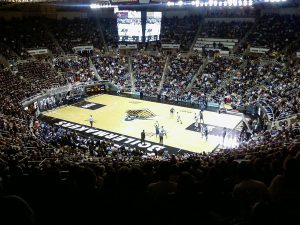I love statistics – and I think you can use statistics to really understand the great game of college basketball. That being said, I don’t completely understand the ESPN statistics department.
ESPN Stat Department’s Paul Sabin’s commitment to BPI model is admirable – but mis-guided. Here are a couple comments that make this statistical model look bad.
“Highest leverage game of the day is TCU vs Oklahoma State. With a win BPI projects TCU has a 82 pct chance to make the tournament. With a loss, that drops to 5 (!)”
First of all, this is ridiculous. TCU has a net ranking of 47, a 19-12 record with a horrible 7-11 record in the Big 12, and only 3 Quadrant 1 Wins with a sweep against Iowa State and a road victory against Texas. So, I might agree with the model that if they lose to 12-20 Oklahoma State that their chances significantly decrease – maybe even to 5%. But are we really going to say that beating that team jumps them to 82%. I guess maybe they were saying that TCU was an 82% chance to make the tournament before this game, so if they win – they stay at 82%. And while I think I might say TCU is in the field – I am not sure I am at the point to say that I would give them an 82% chance,
To be fair, this has always been my complaint about how ESPN uses the BPI model – I have seen times where they will state the in-game part of their model says a team has a 99% chance of winning – just to watch the other team come back. It moves too quickly to the extremes.
“With the win BPI projects that Wofford will most likely be a 5 or 6 seed. BPI still gives UNC Greensboro a 60 percent chance of an at-large bid due to its resume highlighted by its SOR rank of 30 entering today.”
I will go deeper into this because of the next quote. But UNC Greensboro might have a high BPI score, but they have a NET ranking of 57 with only 2 quadrant 1 wins. I love the little guys – I would much rather watch a 28-6 UNC Greensboro team get a chance that a 17-14 major conference team that is getting recognized for pulling out a couple of the many chances they got against the top teams.
But this statement makes the BPI model look stupid. The Southern Conference has never received an at-large bid. Even when Davidson in 1996 was 25-3, won the regular season and were upset in the conference championship final by Western Carolina, Davidson was snubbed by the Selection Committee. And UNC Greensboro did not win the Southern Conference regular season champion – Wofford, the team that beat them in the championship – went undefeated. While we don’t know how the NET ranking is going to be used, there were very few small conference schools that had a ranking over 50 that still got an at-large. Yet, UNC Greensboro has a 60% chance of bucking all that history and get the Southern Conference’s first at-large bid ever. I will be happy if UNC Greensboro gets a chance – but are we really supposed to believe when it has never happened before, that this team has a 60% chance……. Really!?!?!?!?!?!?! But this gets me to the thing that really pushed my buttons.
“Blind Resumes: Team A: 4-3 against Quad1, 26-0 otherwise. Team B: 2-6 against Quad1, 24-0 otherwise. Both lost in conference tournament final. Team A is Gonzaga who may get a No. 1 seed and Team B is UNC Greensboro who may get left out. ESPN’s Strength of Record (SOR) has the two ranked 8th and 31st respectively.”
This is one of the most extreme misuse of cherry picking statistics that you want to make your point. First of all, while the concept of the blind resume is fun (and I have even done it before on my blog), it is not realistic. At the end of the day, the Selection Committee is not blind – they look at the entire profile – and this blind resume hides a few key differences…..So, lets dig deeper.
Team A (Gonzaga) is ranked #2 by the NET ranking (as much as ESPN might love their BPI – the NCAA uses their own ranking). Team B (UNC Greensboro) has a NET ranking of 57. There is a big difference between 2 and 57.
Gonzaga’s Quadrant 1 4-3 record is a 2 point victory over #3 Duke, a 3 point loss to #6 Tennessee, a 13 point loss at #7 UNC, a 14 point victory at #34 St. Mary’s, the surprising 13 point loss in the WCC championship to St. Mary’s, a 11 point victory at #54 Creighton, and a 13 point victory at #72 San Francisco.
UNC Greensboro’s Quadrant 1 2-6 record is a 17 point loss at #5 Kentucky, a 6 point loss at #14 LSU, three losses of 29 pts, 30 pts and 12 points to #13 Wofford. a 10 point loss at #41 Furman, a 4 point victory on a neutral court against Furman, and a 7 point victory at #71 East Tennessee State. Is ESPN really trying to say that beating Duke (at a time when people felt Duke might be unbeatable), St. Mary’s, Creighton, and San Francisco is almost the same as beating Furman and East Tennessee State. UNC Greensboro deserves credit for playing a tight game against LSU and forcing Wofford to go on an amazing run at the end of the conference championship. But they also were blown out in three of those top games against Kentucky and Wofford. You can’t simply look at record – who you played and how close you played matters.
But lets keep going – ETSU is 2-0 against Quadrant 2 – their home wins against Furman (10 pts) and East Tennessee State (1 pt) Gonzaga is 6-0 against Quadrant 2 – with home wins against St. Mary’s, Pac 12 champion Washington, San Francisco, a neutral court victory against Arizona, and road games against BYU and San Diego.- and the only one of those games that they didn’t win by double digits was the one against Washington (their average margin of victory in those 6 games was 23.2 points). There is a big difference between winning 6 of these games by an average of 23.2 points vs. winning 2 of these games by an average of 5 points (against 2 teams that are not at the same level as the 6 that Gonzaga played).
But I am not done. Lets look at the rest of the those games. UNC Greensboro certainly won the games they were supposed to win – going 22-0 against Quadrant 3 and Quadrant 4. In those 22 games, they had an average victory of 11.5 points, with 5 of them being by 20+ points, and another 3 by 10+ points. That means that 14 of them were within single digits.
Gonzaga went 20-0 against those two Quadrants. Their average margin of victory was 32.3 points – where 16 of their 20 wins were by 20+ points, and 3 of them were by 10+ points (only the one game against Illinois was single digits). Is ESPN really trying to say that winning 95% of your games by double digits is a similar profile to winning 36% of your games.
One more point of comparison – now it is my turn to cherry pick. This is completely unfair – but I am on a rant. Lets look at same opponents. Sadly, they really didn’t have many – in fact, my tired eyes can only see one – #311 North Alabama. UNC Greensboro snuck out a 53-48 victory against North Alabama. Gonzaga won 96-51. While one game is not a fair comparison (Gonzaga crushed St. Mary’s in the regular season and still lost by 13 in the championship game), it is still a comparison point – and on that comparison point, the teams are not close.
These profiles are nowhere close to similar. They might have a 26-0 record vs. a 24-0 record – which looks the same. But the teams Gonzaga played in that were slightly tougher, and Gonzaga won 19 of those 26 games by 20+ points. UNC Greensboro won 5 of them by 20+ points. We could argue if Gonzaga’s profile says it should be a #1 seed. There are very few teams that could have beat almost everyone they play by 20+ points, beat Duke by 2 and lose to Tennessee by 3. It might be fair to say that maybe there are 4 teams out there that could have done that (which would knock the Zags to a 2 seed), but they are firmly one of the best teams in the country.
UNC Greensboro had a great season – but they more often than not were blown out when they played a top 20 team, and they didn’t destroy the weaker opponents that you would expect a tourney team to do. To prove that discussion, lets look at fellow bubble team Indiana – with a NET ranking of 51 and a 17-14 record. They only played 9 games in Quadrants 3 and 4 – winning them all. 4 of those were by 20+, 3 of them were by 10+ points, and the two that were close were Illinois and Northwestern – their average margin was 23.4 points in this group (more than double UNC Greensboro’s margin). Indiana’s problem is that they have so many losses – but based on these 9 games, it looks like if you gave the Hoosiers the schedule that UNC Greensboro played, they would have been more dominant in those games.
Doing a blind resume test – picking out records – and saying they look the same is just not fair. You can’t look at these resumes blindly – If I go 1-1 against Duke and North Carolina – that is simply different that going 2-0 in road games against San Francisco and East Tennessee State. I can’t compare those records even though I am trying to fairly group the teams into groups. I have to look at each game and each result.
It can be fun when you do it by two teams that are really close to each other and give a few more details. But picking the #2 team and the #57 team in the rankings saying they have similar records in Quadrant 1 and the remaining Quadrants and wondering why they are considered to be so different is a poor use of statistics – and really make it look like the ESPN Stats Department has no clue of what they are talking about.

